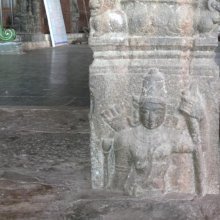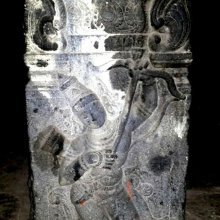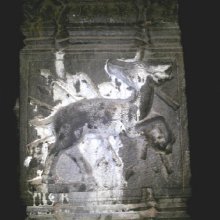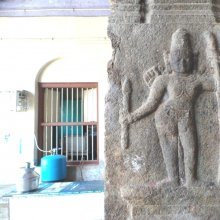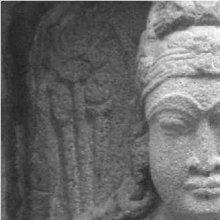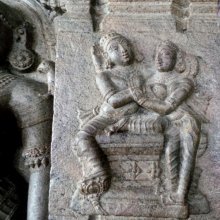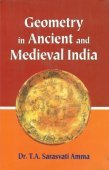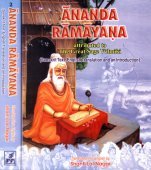Arrow: 4 definitions
Introduction:
Arrow means something in Buddhism, Pali, Hinduism, Sanskrit, the history of ancient India. If you want to know the exact meaning, history, etymology or English translation of this term then check out the descriptions on this page. Add your comment or reference to a book if you want to contribute to this summary article.
Images (photo gallery)
(+88 more images available)
In Hinduism
Natyashastra (theatrics and dramaturgy)
Source: Shodhganga: Elements of Art and Architecture in the Trtiyakhanda of the Visnudharmottarapurana (natya)Arrows are associated with Tripatāka-hasta: one of the twenty-two Single-hand Gestures (in Indian Dramas) (known as asaṃyuktahastas), according to the Viṣṇudharmottarapurāṇa, an ancient Sanskrit text which (being encyclopedic in nature) deals with a variety of cultural topics such as arts, architecture, music, grammar and astronomy.—According to the Abhinayadarpaṇa, the tripatāka hand is used to denote some objects like crown, arrows, tree, the ketakī flower, lamp etc. This hand posture shows the action of writing letters. Indra along with his weapon i.e., vajra, is also shown with this hand posture in Dance.

Natyashastra (नाट्यशास्त्र, nāṭyaśāstra) refers to both the ancient Indian tradition (shastra) of performing arts, (natya—theatrics, drama, dance, music), as well as the name of a Sanskrit work dealing with these subjects. It also teaches the rules for composing Dramatic plays (nataka), construction and performance of Theater, and Poetic works (kavya).
Shilpashastra (iconography)
Source: Shodhganga: Elements of Art and Architecture in the Trtiyakhanda of the Visnudharmottarapurana (shilpa)1) Arrows in iconography is associated with Viṣṇu, according to the Viṣṇudharmottarapurāṇa, an ancient Sanskrit text which (being encyclopedic in nature) deals with a variety of cultural topics such as arts, architecture, music, grammar and astronomy.—The Viṣṇudharmottarapurāṇa states that the image of Viṣṇu should have four faces and eight arms. In his right hands there should be some equipments like arrows, a rosary, a club and the left hands should possess a shield, a garment and a rainbow. Thus it is clear that the Viṣṇudharmottarapurāṇa offers a great field of knowledge regarding the nuances of Indian art of Image making [e.g., arrows] during 10th–11th century A.D.
2) An Arrow is denoted by the Sanskrit word Śara, and follows specific guidelines of ancient Indian Painting (citra).—In the Viṣṇudharmottarapurāṇa also, different kinds of eyes and their particular shapes are elaborately discussed in the context of Painting. The fifth variety of eye should be in the shape of a śara i.e., an arrow and the measurement should be ten yavas. This kind of eyes should be attached with the portrait of a person who is in anger or pain.

Shilpashastra (शिल्पशास्त्र, śilpaśāstra) represents the ancient Indian science (shastra) of creative arts (shilpa) such as sculpture, iconography and painting. Closely related to Vastushastra (architecture), they often share the same literature.
In Buddhism
Mahayana (major branch of Buddhism)
Source: Brill: Śaivism and the Tantric Traditions (mahayana)Arrows are used as a material in the performance of a sacred bathing ritual dedicated to Goddess Sarasvatī, according to the seventh chapter of the Suvarṇaprabhāsottamasūtra.—In chapter 7, the Sarasvatīparivarta, the goddess Sarasvatī grants her support to the Dharma preacher through the gift of eloquence, and presents a bathing ritual with enchanted herbs for him and his audience in order to appease all disturbances. It is promised that, invoked by praise, Sarasvatī herself will appear and remove all diseases and difficulties. The ritual instructions prescribe that one should pound herbs and consecrate the powder with mantras at the time of the Puṣya constellation. A maṇḍala should be drawn with cow-dung, flowers should be scattered and gold and silver vessels filled. Four armed men and four well-adorned maidens should be placed there holding pots in their hands, thus accomplishing the protective sealing of the boundaries (sīmābandha). One should use incense, music, umbrellas, flags, banners, mirrors, arrows, spears and dhāraṇī-spells, and in due course bathe behind an image of the Buddha.

Mahayana (महायान, mahāyāna) is a major branch of Buddhism focusing on the path of a Bodhisattva (spiritual aspirants/ enlightened beings). Extant literature is vast and primarely composed in the Sanskrit language. There are many sūtras of which some of the earliest are the various Prajñāpāramitā sūtras.
India history and geography
Source: Singhi Jain Series: Ratnaprabha-suri’s Kuvalayamala-katha (history)Arrows (as a weapon) were commonly depicted on the Saṃsāracakra paintings (representing scenes of human life), in ancient India, as mentioned in the Kathās (narrative poems) such as Uddyotanasūri in his 8th-century Kuvalayamālā (a Prakrit Campū, similar to Kāvya poetry).—Page 185.21 f.: Here follows a description of a printed scroll illustrating the Jaina conception of saṃsāracakra. [...] The saṃsāra-cakra illustrated the three worlds of hell, human world and the world of gods. [For example:] Persons shooting animals with bow and arrow; a person holding a naked sword and showing feats of swordsmanship; parrots and magpies put in cages for amusement

The history of India traces the identification of countries, villages, towns and other regions of India, as well as mythology, zoology, royal dynasties, rulers, tribes, local festivities and traditions and regional languages. Ancient India enjoyed religious freedom and encourages the path of Dharma, a concept common to Buddhism, Hinduism, and Jainism.
See also (Relevant definitions)
Starts with: Arrow grass, Arrow poison plant, Arrow poison tree, Arrow reed, Arrow weed, Arrow wood, Arrow-leaf, Arrow-leaf aster, Arrow-leaved monochoria, Arrow-poison strophanthus, Arrowhead, Arrowhead sweet coltsfoot, Arrowhead vine, Arrowleaf buckwheat, Arrowleaf sweet coltsfoot, Arrowleaf violet, Arrowroot.
Ends with: Boar marrow, Bow and arrow, Common yarrow, Crocodile marrow, Fragrant yarrow, Garrow, Human marrow, Madeira marrow, Red arrow, Siberian yarrow, Sparrow, Western yarrow, Wood sparrow, Yarrow.
Full-text (+2959): Bana, Sara, Sharavarsha, Sayaka, Ishu, Punkha, Shilimukha, Bhalla, Naraca, Prishatka, Ajihmaga, Sharavya, Maheshu, Sriga, Kshurapra, Margana, Shoshana, Shalya, Agnivana, Svaru.
Relevant text
Search found 282 books and stories containing Arrow; (plurals include: Arrows). You can also click to the full overview containing English textual excerpts. Below are direct links for the most relevant articles:
The Padma Purana (by N.A. Deshpande)
Chapter 27 - Killing of Citrāṅga < [Section 5 - Pātāla-Khaṇḍa (Section on the Nether World)]
Chapter 62 - Lava Becomes Unconscious < [Section 5 - Pātāla-Khaṇḍa (Section on the Nether World)]
Chapter 69 - The Slaying of Tāreya < [Section 1 - Sṛṣṭi-khaṇḍa (section on creation)]
Maha Prajnaparamita Sastra (by Gelongma Karma Migme Chödrön)
Appendix 1 - The example of the master-archer < [Chapter XXXI - The Thirty-seven Auxiliaries to Enlightenment]
The Śalyatvena-sūtra (Sallattena-sutta) < [Chapter XXXVII - The Ten Concepts]
Part 1 - The auxiliaries belong to the Greater Vehicle as well < [Chapter XXXI - The Thirty-seven Auxiliaries to Enlightenment]
Mahabharata (English) (by Kisari Mohan Ganguli)
Section CXIV < [Bhagavat-Gita Parva]
Section 48 < [Karna Parva]
Section CLXVIII < [Ghatotkacha-badha Parva]
The Shiva Purana (by J. L. Shastri)
Chapter 21 - Description of the Special War < [Section 2.5 - Rudra-saṃhitā (5): Yuddha-khaṇḍa]
Chapter 22 - The destruction of Dakṣa’s sacrifice (3) < [Section 7.1 - Vāyavīya-saṃhitā (1)]
Chapter 17 - The fight between Viṣṇu and Jalandhara < [Section 2.5 - Rudra-saṃhitā (5): Yuddha-khaṇḍa]
The Great Chronicle of Buddhas (by Ven. Mingun Sayadaw)
Part 5 - The Archery Display < [Chapter 2 - The Performance of the Ploughing Ceremony]
Part 1 - Story of Kukkuṭamitta the Hunter < [Chapter 34c - The Buddha’s Nineteenth Vassa also at Cāliya Hill]
Part 10 - Story of Pokkharasāti Brahmin and Ambaṭṭha < [Chapter 35 - Story of Māra]
Nitiprakasika (Critical Analysis) (by S. Anusha)
Related products
